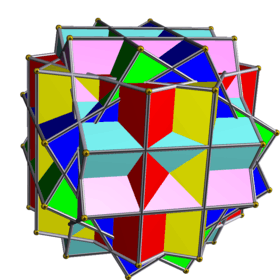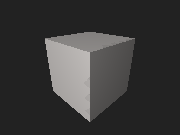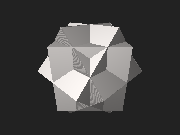Compound of six cubes with rotational freedom
This uniform polyhedron compound is a symmetric arrangement of 6 cubes, considered as square prisms. It can be constructed by superimposing six identical cubes, and then rotating them in pairs about the three axes that pass through the centres of two opposite cubic faces. Each cube is rotated by an equal (and opposite, within a pair) angle θ.
| Compound of six cubes with rotational freedom | |
|---|---|
 | |
| Type | Uniform compound |
| Index | UC7 |
| Polyhedra | 6 cubes |
| Faces | 12+24 squares |
| Edges | 72 |
| Vertices | 48 |
| Symmetry group | octahedral (Oh) |
| Subgroup restricting to one constituent | 4-fold rotational (C4h) |
When θ = 0, all six cubes coincide. When θ is 45 degrees, the cubes coincide in pairs yielding (two superimposed copies of) the compound of three cubes.
Cartesian coordinates
Cartesian coordinates for the vertices of this compound are all the permutations of
Gallery
gollark: And Eka.
gollark: Rewrite it in Amùlet.
gollark: Just give every player 256 turtles in case they lose any.
gollark: `require` returns what the fīle retürns.
gollark: There's the problem.
References
- Skilling, John (1976), "Uniform Compounds of Uniform Polyhedra", Mathematical Proceedings of the Cambridge Philosophical Society, 79: 447–457, doi:10.1017/S0305004100052440, MR 0397554.
This article is issued from Wikipedia. The text is licensed under Creative Commons - Attribution - Sharealike. Additional terms may apply for the media files.

.stl.png)
.stl.png)
.stl.png)
.stl.png)
.stl.png)
.stl.png)
.stl.png)
.stl.png)
